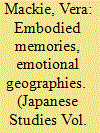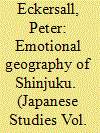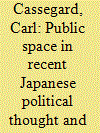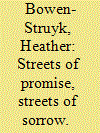|
|
|
Sort Order |
|
|
|
Items / Page
|
|
|
|
|
|
|
| Srl | Item |
| 1 |
ID:
108787


|
|
|
|
|
| Publication |
2011.
|
| Summary/Abstract |
In this article I carry out a close reading of Nakamoto Takako's book, My Diary of the Anpo Struggle (1963). Nakamoto was a writer and activist who was active in leftwing politics, the labour movement and the proletarian literature movement in the 1920s and 1930s and returned to the movement after 1945. Her published diary recounts her participation in the struggle against the renewal of the US-Japan Security Treaty and her other political activities. The book is a mixture of personal memory and political history and provides us with a distinctive 'map' of one person's emotional geography of Tokyo.
|
|
|
|
|
|
|
|
|
|
|
|
|
|
|
|
| 2 |
ID:
108788


|
|
|
|
|
| Publication |
2011.
|
| Summary/Abstract |
Ouchida Keiya's Chikatetsu Hiroba (Underground Plaza, 1970), a film from the Japanese underground cinema movement, documents the gathering of 'folk guerrillas' (activists and student protestors) at the underground plaza linking the west and east exits of the vast Shinjuku railway station in February 1969. This essay analyses their protests by highlighting their apparent search for a new performative praxis, amidst evidence of complicated broken threads, misplaced emotions and disconnections between politics and action. Through occupying and restoring other uses of the space, I argue that the protestors desired to remake the city as a forum for ideological confrontation and revolutionary aesthetics.
|
|
|
|
|
|
|
|
|
|
|
|
|
|
|
|
| 3 |
ID:
108791


|
|
|
|
|
| Publication |
2011.
|
| Summary/Abstract |
In this article I discuss the ways in which the 2008 film Tokyo Sonata engages with the contrasting emotional and physical geographies of comfortable suburbia and the contemporary reality of socio-cultural despondency. The Sasaki family is the embodiment of the quintessential nuclear family of urban, middle-class Japan. Their world starts unravelling the day the father, Sasaki Ryuhei, is laid off from his middle-management job. Unwilling to reveal this to his family, Ryuhei continues to leave for work each morning dressed in his suit, but spends his days in a park inhabited by homeless men. Ultimately, he finds employment as a cleaner in a shopping mall. Ryuhei's journey from white-collar salaryman to menial worker is set against the backdrop of collective anxiety in the intermeshing physical and emotional 'scapes' of recession-era Tokyo. I argue that, at the core, this is an anxiety about the loss of masculine authority in the home and the workplace, and at the level of Japan as a nation. Moreover, it is an anxiety that cannot be fully appreciated without reference to the framing social, cultural, economic and emotional topographies of post-bubble Japan.
|
|
|
|
|
|
|
|
|
|
|
|
|
|
|
|
| 4 |
ID:
108792


|
|
|
|
|
| Publication |
2011.
|
| Summary/Abstract |
When narrated by children, social issues achieve new emotional meanings. A prime example of such a narration is the transmedia 'homeless student' phenomenon. The 2007 autobiographical novel Homuresu chugakusei (Homeless Junior High School Student) by comedian Tamura Hiroshi sold millions of copies and was adapted into television drama, film, manga, children's books and spoofs. Tamura's brother Ken'ichi retold the story in Homuresu daigakusei (Homeless University Student), also televised. The Tamuras make visible the homeless who are often overlooked. Yet their goal is not to promote awareness of diverse homelessness during economic recession but instead to inspire readers and make them appreciate the value of home. I read Homeless Junior High School Student alongside texts that present urban homelessness as an antidote to excesses of middle-class society. I question the impact of these uplifting accounts on public perceptions of poverty. I argue that Homeless Junior High School Student and related texts can be read as a dominant strand of popular culture that promotes the family as the backbone of Japan and the sole unit of care.
|
|
|
|
|
|
|
|
|
|
|
|
|
|
|
|
| 5 |
ID:
108793


|
|
|
|
|
| Publication |
2011.
|
| Summary/Abstract |
In this article I consider recent homeless activism in Tokyo's Miyashita Park, including the celebration of 'vacant lots' (akichi), and what this can tell us about notions of publicness in Japan. We can provide further depth to the discussion of publicness by situating recent activism in the context of the work of historians such as Amino Yoshihiko and Higashijima Makoto and their recovery of indigenous Japanese conceptions of 'publicness' and 'the public sphere'. The implications of formulations of 'the public' based around terms such as oyake/ko and alternatives including muen are examined, as well as meanings historically ascribed to the Zen concept of 'lakes and rivers' (goko/koko). I also trace Japanese responses to classical Western notions of the public sphere, as well as some challenges to them in Western scholarship, including the notion of 'counterpublics'. Whereas in Western modernity the bracketing of social inequalities was considered a prerequisite for the deliberative function of the public sphere, in premodern and early modern Japan there were spaces which allowed for the bracketing of differences even where the function of deliberation was not emphasised.
|
|
|
|
|
|
|
|
|
|
|
|
|
|
|
|
| 6 |
ID:
108786


|
|
|
|
|
| Publication |
2011.
|
| Summary/Abstract |
In this article I read the public space and streetscapes of early-Showa Tokyo through the lens of proletarian writers. I use the conceptual tools provided by cultural geographers, in particular the concept of emotional geography. Activists of the late 1920s co-opted the streets to distribute leaflets and engage in other forms of agitation. Through their actions they attempted to reinscribe the meaning of the streets, extending even to the ceremonial plazas laid out to showcase imperial power. The risks and exhilarations of such activity are vividly recounted in works including Tokunaga Sunao's 'The Sunless Street', Sata Ineko's poem 'Leafleting', and Kobayashi Takiji's posthumously published novella, 'The Life of a Party Member'. Takiji's novella details the dangerous cat-and-mouse game underground activists played as they worked on behalf of the illegal Communist Party and dodged the surveillance of the secret police.
|
|
|
|
|
|
|
|
|
|
|
|
|
|
|
|
| 7 |
ID:
108790


|
|
|
|
|
| Publication |
2011.
|
| Summary/Abstract |
Understandings of urban space in Tokyo underwent two significant revisions in the 1990s, focused on the spaces of the subway and the street. These revisions occurred around the 1995 subway sarin gas incident and in the revival of street protest in new social movements. The article brings together the two spaces by discussing how one group of sarin incident victims staged a commemorative event in 2005 - the Memorial Walking Care - to re-engage with underground sites of traumatic memory by walking a Underground route above them along the streets. It draws on the recognition in Murakami Haruki's Underground of a violence in Japanese society figuratively and literally lurking beneath the feet; and on sociologist Mori Yoshitaka's theorisation of the street as a potential site for new oppositional politics. Situating the event within the frames of trauma theory and performance studies, I read the Memorial Walking Care as both traumatic repetition of loss and potential working through of trauma. The underground and the street act as spatial and conceptual markers for the difference between these processes.
|
|
|
|
|
|
|
|
|
|
|
|
|
|
|
|
| 8 |
ID:
108789


|
|
|
|
|
| Publication |
2011.
|
| Summary/Abstract |
The city of Tokyo has been a space where numerous forms of sexual subcultures and their histories have been born. This paper discusses one possible way of understanding queer space in Tokyo. Examining the discourses concerning Shinjuku Ni-chome, a queer neighbourhood in Tokyo, I argue that this queer space functions as a discursive site of containment as well as resistance to hetero-normative narratives of the metropolis. Drawing on queer theories that focus on the notion of space, in this paper I demonstrate that queer space is often marginalised by mainstream society, but at the same time it can be a critical site through which to investigate hetero-normativity. I suggest that queers themselves sometimes deploy their own delegitimised status to construct a queer counter-public space that intervenes in and disorients the linear narrative of hetero-normative views.
|
|
|
|
|
|
|
|
|
|
|
|
|
|
|
|
|
|
|
|
|